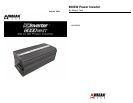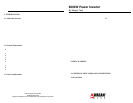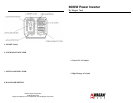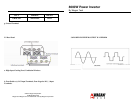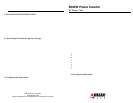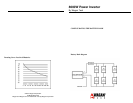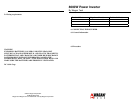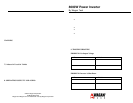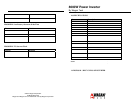
USER’S MANUAL — Please read before using this equipment.
© 2007 Wagan Corporation.
All Rights Reserved.
Wagan and Wagan.com are trademarks used by Wagan Corporation.
9
8000W Power Inverter
By Wagan Tech
www.wagan.com
10
5. PLANNING THE INVERTER SYSTEM
2. Estimate the number of hours the appliances will be in use between battery
recharges. This will vary depending on appliances. For example, a typical home-
use coffeemaker draws 500 watts during its brew time of 5 minutes, it maintains
he temperature of the pot at about 100 watts. Typical use of a microwave oven is
only for a few minutes. Some longer operating time appliances are lamps, TV's,
computers and refrigerator/freezers.
Larger wattage inverters require planning before installation. There are several
steps to the planning process. The user must determine the following:
1. Maximum inverter wattage required
2. Operating time (run time) needed between battery recharges
3. Determine the total watt-hours of energy needed. This is done by multiplying
the average power cons umption in watts by t he number of hours of run tim e. For
example: 1500 watts for 10 hours = 15,000 watt hours.
3. Battery bank capacity in amp-hours
4. Charger requirement to recharge batteries within a reasonab le time.
To get an estimate of the maximum current (in amps) that a battery bank must be
capable of delivering to the inverter, divide the load watts by ten. For example a
1500 watt appliance load will need 150 amps at 12 Volts DC.
5.1 Determining The Maximum Appliance Wattage
Using the 1500 watts (or 150 Amps) for 10 hours example as above, then 150
amps is needed for 1 0 ho u rs. Thi s provides us with the bas i c amp-hours (AH) of
battery that is required. Ten hour s at 150 amps equals 1500 Amp Hours (AH).
This answer is just a beginning because there are other factors that determine
actual run time. These include:
Maximum Appliance Wattage is the first factor in planning battery and charging
systems.
Some background:
Large microwave oven specifications list cooking power (watts) and appliance
power. Appliance power is the AC load the inverter has to supply.
Most other electrical tools, appliances and audio/video equipment have labels that
list the unit's power requirements in watts. If the tool or device is rated in amps,
multiply the amps by 115 (115-VAC) to determine the watts. For example, a
power tool rated at 4-amps will draw 460 watts.
• AC appliance load and time in use (basic AH)
• Cable gage and length (cable losses)
• Charge level of the batteries (between use, chargers have to be able
Determine the wattage of each appliance you need to simultaneously operate. Add
all of the appliance wattages to obtain an estimated “total watts” number.
Remember to consider the start-up surge that motorized appliances will cause. Do
not exceed the surge ratin g of t he invert er.
• to fully charge the batteries)
• Temperature of the batteries (colder batteries provide fewer amps)
• Age and condition of the b a tteries (older batteries lose capacity)
• Compliance with turning off unnecessary AC loads.
• Compliance with turning off unnecessary DC loads.
At 8000 watts continuo us output this inverter requires a DC power supply (batter y
bank) that can continuously supply 800 amps at 12VDC for the duration of the
run time.
5.3 Derating the Battery Bank
5.2 Configuring the Battery Bank
Most lead-acid batteries have a rating expressed in amp-hours (AH). The most
common rating of AH is “at the 20 hour rate”. For example; if a 20AH battery is
discharged at a 1 amp rate, is will take 20 hours to discharge that battery. The
terms “charged” and “discharged” relate to actual battery voltage. This mean s that
the output voltage of a nominal 12 volt battery starts at 13.2 volts (fully charged)
then drops to 10.6 volts (discharged). If the load on the battery causes the battery
To determine the minimum battery ampere-hour rating that you will need to
operate appliances from the inverter, and any DC appliances powered by the
battery bank. Follow these step s:
1. List the maximum wattage that the inverter has to provide (as above).



